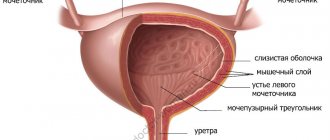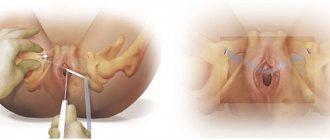It happens that when jumping rope or trampoline, or while running, an adult involuntarily leaks urine. This kind of urinary incontinence, which occurs exclusively during physical activity or jumping, is called stress incontinence.
More often, the pathology is diagnosed in pregnant and postpartum women. This is due to increased abdominal pressure during pregnancy and muscle strain during childbirth.
This condition causes significant discomfort, but with proper and timely treatment, the problem can be completely eliminated.
Therapy should be comprehensive, using psychological correction, medications, diet, strengthening exercises, and physical procedures.
Causes of urinary incontinence when jumping
With stress incontinence, urine is released during physical activity, without preliminary urges. Patients note the manifestation of urinary incontinence syndrome when jumping on a trampoline, skipping rope, running, severe coughing or sneezing.
The main reason that involuntary urination occurs when jumping is weakness of the pelvic floor muscles and impaired conduction of nerve impulses. It is believed that representatives of the fairer sex are more susceptible to violations.
Urinary incontinence in women during physical activity during pregnancy is associated with increased pressure of the uterus on the pelvic area. Difficulties often arise when carrying a large fetus.
Problems in the postpartum period can occur due to a difficult birth, when the muscles are stretched more than usual.
In addition, urinary incontinence when jumping on a trampoline or skipping rope, or running is associated with:
- menopause in women;
- gynecological and urological pathologies;
- hormonal changes;
- diseases of the respiratory system;
- great physical activity;
- stool disorders;
- obesity;
- surgeries on the genitourinary system;
- stress;
- prostate adenoma in men;
- Parkinson's disease or stroke;
- taking certain medications;
- injury to the pelvic organs;
- abnormalities in the development of the urinary system;
- mental disorders.
Patients with a genetic predisposition are more likely to suffer from this syndrome.
Diagnostic examination
The cause of such an intimate problem as urinary incontinence in women during running and physical activity is at the intersection of two specializations - the genital area and urology. It may be necessary to examine the endocrine and nervous systems, exclude gastroenterological pathologies, and eliminate obesity.
Differential diagnosis of enuresis of various types begins with a thorough history taking. Therefore, you should not be surprised if a specialist starts asking unexpected questions. The doctor needs to clarify the conditions of origin of the delicate situation, the amount of urine excreted, and risk factors. The treatment method depends on this.
The examination includes:
- filling out a questionnaire;
- gynecological examination, consultation with a urologist;
- clinical laboratory and bacteriological urine tests;
- Ultrasound of the pelvic organs;
- cystography;
- combined urodynamic study.
Cough and pad tests are of diagnostic value. The first is sometimes negative in the case of prolapse of the internal female organs. The second is carried out in simplified (4 hours) or detailed (days) versions. The point is to clarify the amount of involuntarily lost urine. Weighing the pad will help determine the degree of incontinence caused by skipping rope, running, or trampoline.
Mechanism of development of the disorder
Involuntary urination in women and men during jumping, running, and when doing strength sports is called stress incontinence. In this case, the patient does not feel the urge to go to the toilet.
Emptying the bladder is associated with an increase in intra-abdominal pressure.
It often occurs in women during pregnancy, when the uterus enlarges and descends, squeezing all the organs of the abdominal cavity.
After childbirth, urinary incontinence when jumping is possible for about another 2-3 weeks, since the muscles need time to recover after natural stretching at the birth of the baby.
The act of urination is controlled by the nervous system. When the bladder is empty, the urethral sphincters are closed, and the muscular wall of the bladder is in a relaxed state.
As the organ fills, the pressure on the walls increases, and the nerve fibers located in them send a signal to the cerebral cortex.
Having received the feedback, the detrusor contracts, the sphincter relaxes, and urine flows out of the bladder through the urinary canal.
Incontinence can occur when jumping when at least one of the mechanisms gets out of control.
If the supporting muscular-ligamentous structure is weakened, the tone of the urethra increases, the closing function of the sphincter of the urinary canal is disrupted, and the transmission of nerve impulses fails, then urine is not retained in the bladder and leaks out.
Preventive measures
The following simple preventive measures, which not all patients actually have the willpower to adhere to, contribute to improving the condition in combination with the treatment:
- Losing excess weight - it has been proven that every extra kilogram increases the risk of developing incontinence by 3%.
- Quitting cigarettes - smokers have a deficiency of vitamin C, impaired tissue microcirculation, increased collagen breakdown, which helps reduce sphincter tone.
- A balanced diet and sufficient water consumption - spicy foods and fluid deficiency provoke irritation of the bladder wall, and straining during constipation increases the risk of urinary incontinence.
- Combating physical inactivity - feasible physical exercise helps strengthen muscles.
- Treatment and monitoring of chronic diseases of the respiratory system, digestion, and cardiovascular system.
It is necessary to clearly orient the patient towards the goal and result, only then can commitment to the implementation of these tips be achieved.
Diagnostics
If involuntary urination occurs during jumping, the doctor will prescribe the following to determine the cause:
- general analysis of urine and blood;
- Ultrasound of the urinary system. Allows you to assess their condition, identify tumors, stones, dysplasia and other damage and disorders.
- urodynamic study. Provides information about the functioning of the bladder.
All patients need to keep a urination diary, where they need to record the time of emptying, the amount of urine, the nature of the stream, and the volume of liquid drunk per day.
Women need to visit a gynecologist.
How to treat urine leakage in women
What to do if a girl involuntarily leaks urine is described in detail on a separate page - you can open it by clicking on the link picture at the bottom of the page. Briefly, the essence of the issue is as follows. Since the main reason why a girl peed herself while laughing, sneezing, jogging, jumping and squatting, and other similar situations lies in the weakening and impairment of the muscles of the pelvis and perineum, treatment should be aimed at correcting these issues.
✅ The following procedures can play a positive role in solving this problem:
· Vaginal devices (simulators) to strengthen intimate muscles; · Injections of fillers into specified points; · Manual massage of the pelvic organs.
Treatment methods
When treating urinary incontinence in women and men when jumping, therapy is selected individually. Treatment must be comprehensive, since the use of medications will not bring the desired effect without muscle strengthening exercises.
To normalize the urination process and prevent involuntary urination when jumping, women and men may be prescribed:
- diet. Recommended for overweight people who have problems with urine output related to their weight;
- taking medications;
- psychotherapy to stabilize the psychological state;
- therapeutic exercises to strengthen muscles;
- physiotherapy;
- surgery. The operation is performed only if there is no effect from conservative therapy.
Medications are prescribed depending on the cause of incontinence.
- If infection or inflammation is detected, then anti-inflammatory drugs and antibiotics are needed.
- If there is a hormonal imbalance, take medications that normalize hormonal levels.
- If the illness is psychogenic, antidepressants may be required.
In addition, all patients with enuresis are prescribed anticholinergic drugs to relieve involuntary muscle contractions.
During treatment, you need to control the amount of fluid you drink and monitor your diet, avoiding diuretic foods and drinks.
Physiotherapy is usually combined with gymnastics and psychotherapy. Electromagnetic procedures, electrophoresis, vibration massage, diadynamometry, and galvanotherapy are popular.
The duration of the course depends on the age, condition of the patient, the nature of the underlying disease or disorder.
Bladder training is very useful, in which you need to go to the toilet on a schedule, and when an unwanted urge to empty occurs, you need to restrain it.
Incontinence surgery helps provide additional support using a special prolene tape. It is laid under the urethra.
For the best effect after surgery, it is necessary to stop carrying heavy objects and temporarily stop intimate life. Usually the operation is performed no earlier than a year from the start of conservative treatment.
Less often they resort to urethrocystocervicopexy, when the neck of the bladder and the organ itself are fixed in the correct position.
If incontinence is associated with uterine prolapse, then treatment to correct genital prolapse is required before urological treatment.
In women, a plastic or silicone pessary may be installed. When inserted into the vagina, it creates pressure on the walls of the urinary canal, which prevents urine from flowing out spontaneously.
Pessaries are mushroom-shaped, cubic, urethral, cup-shaped. Also, vaginal rings are divided according to the duration of wear.
There are products that are installed for a long time, while others are inserted for a short period, for example, before physical activity.
In order to prevent odor and discomfort from urinary incontinence, patients are advised to wear special urological panties or use pads.
Traditional medicine is used only after consultation with a doctor. Suitable teas include lingonberry, St. John's wort, centaury, nettle, marshmallow, and yarrow.
Pregnant women are prescribed a mixture of St. John's wort, burdock and hernia. A decoction of plantain seeds helps men well.
A set of exercises for urinary incontinence
Having figured out why involuntary urination occurs while jumping rope, you can use a special set of exercises to achieve control over the process of urination.
Kegel gymnastics is recognized as the most effective method of strengthening muscles in the intimate area. You need to do the exercises every day, several approaches, for at least 3-4 months in a row.
Having taken a lying position, you should tense the muscles of the perineum for 3-5 seconds while inhaling, and relax while exhaling. You need to repeat the exercise 15-20 times, daily the amount is increased by 5-10 times until it reaches 100-200.
It is necessary to contract the muscles that are involved in holding back urination; the legs and buttocks are not involved.
In addition to Kegel exercises, there are others that are no less useful:
- Starting position: lying on your back. Arms and legs rise for 5-7 seconds, then smoothly lower. You need to breathe with your stomach.
- While standing, the ball is held between the knees. Squeeze the ball tightly, straining the perineum, hold the tension for 10 seconds, relax.
- Sitting on the floor or on a chair. The legs are crossed, then spread, while the pelvic muscles work.
- Lying on your side. The free leg is bent and pulled towards the chest. Then change sides and repeat with the other leg.
- Lying on your stomach. Alternate leg swings are performed.
- Lying on your back, legs bent at the knees. Smoothly lower your legs to the floor and again take the starting position, pulling your knees to your chest.
Among the well-known exercises, abdominal swings, squats, and bends are useful.
Preventive measures
To minimize the risk of disease or relapse, you need to:
- Avoid lifting or carrying heavy objects.
- Quit smoking and alcohol.
- Stabilize weight.
- Avoid running, jumping, and strenuous sports. It is better to replace them with light exercises, swimming, walking.
- Promptly treat all inflammatory and infectious pathologies of the genitourinary system.
- Avoid diuretic drinks and foods.
- Monitor bowel regularity.
- Avoid taking medications with a diuretic effect.
- Undergo preventive examinations of the genitourinary system annually.
There is no point in starting the disease; when the first symptoms appear, you should consult a doctor. Timely treatment allows you to get rid of the problem forever.









